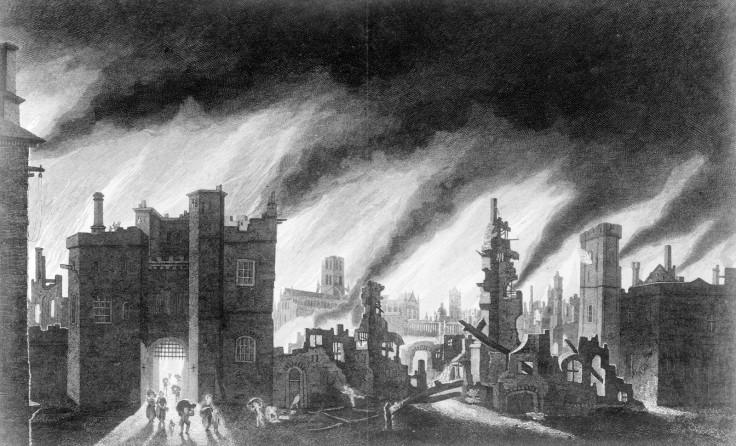Great Fire of London 350th anniversary: 25 key facts about the devastating 1666 blaze
The fire destroyed tens of thousands of homes and buildings over four days.

The British capital will mark the 350th anniversary of the Great Fire of London this week, the most devastating fire in English history. Starting in the early hours of Sunday 2 September 1666, the fire swept across London for four days, making tens of thousands homeless and ravaging shops and businesses.
London monuments such as St Paul's Cathedral were consumed by the blaze, as it spread across the city, fuelled by the cramped, timber structures, the wind and warehouses stocked with combustible products.
On the 350th anniversary of the Great Fire, here are 25 key facts about the blaze and its impact on the capital
- The Great Fire of London started on 2 September and devastated the city until 5 September 1666.
- The fire started in a bakery on Pudding Lane.
- The bakery was owned by Thomas Farriner and the fire was estimated to have started at around 1am.
- Before the fire broke out, London was experiencing a drought so the wooden structures were dry and easily flammable.
- Around 5/6 of the city was consumed by the fire.
- The cost of the destruction caused amounted to around £10m.
- A quarter of the population of London never returned to the city after the fire.

- More than 13,000 houses were destroyed in the fire.
- An estimated 80,000 people were left homeless.
- One man was tried and executed for the blaze, a Frenchman called Robert Hubert.
- Hubert was innocent and had given a false confession, as he was not actually in London when the fire started.
- When the fire reached the northern bank of the River Thames, it was fuelled by combustible products stored in warehouses such as oil.
- Only six deaths were verified and recorded.
- Many poor communities were killed by the fire and smoke, but their deaths went unrecorded.
- When the fire broke out, London had only just recovered from the great plague, which had struck in 1665.
- Fires were not uncommon in London. In 1643, a fire had damaged a considerable portion of the city.
- The fire could not spread across London Bridge, so only the City of London was affected.

- Hundreds of houses were pulled down to try and create fire breaks.
- The fire destroyed more than 80 churches.
- The heat of the blaze was hot enough to melt the City's iron gates. Using a fragment of pottery, which is now in the Museum of London, scientists to estimated the fire reached a temperature of 1,700 degrees Celsius.
- Around 800 buildings were rebuilt by the end of 1667.
- Monuments such as St Paul's Cathedral and the Royal Exchange were destroyed by the fire.
- The Golden Boy of Pye Corner in Smithfield marks the spot where the fire was finally extinguished.
- The Monument to the Great Fire of London, known as the Monument, marks exactly where the fire started. It was erected in 1677.
- The top of the Monument is reached by a narrow staircase of more than 300 steps. In the mid-19th century, a wire mesh was added to the top to prevent people taking their own lives.
© Copyright IBTimes 2025. All rights reserved.



















